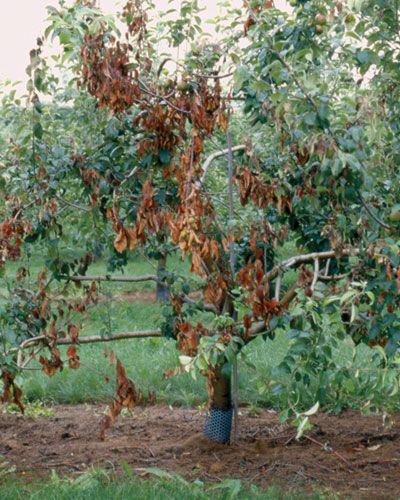

Fire Blight
Fire blight creates different types of symptoms, depending on the plant part that is attacked and when the plant is attacked.
Blossom blight:
- This stage appears around the time of petal fall. Infected blossoms look like they have been soaked in water, wilt, and then turn dark brown.
Shoot blight:
- This is the most obvious stage of symptom expression, which appears one to several weeks after petal fall.
- As the bacteria progresses, leaves wilt, turn brown and remain on the tree. This creates a fire-scorched look; hence the name “fire blight.”
- The branch tips on infected twigs may bend over to create a “shepherd’s crook.”
- Fire blight can also cause dark, sunken cankers that have a narrow callus ridge along the outside. This callus ridge differentiates cankers caused by fire blight from cankers caused by fungal pathogens.
- A creamy bacterial ooze may appear on cankers or fruit.
- Fruit may dry and remain on tree.

Photo: Patrick Anderson, Rainbow Ecoscience
Trees At Risk
Plants in the rosaceous family including
- Cotoneaster
- Firethorn
- Crabapple
- Hawthorn
- Ornamental pear
- Mountain ash
Biology
- Bacteria over winters at the edges of the cankers, in the wood.
- New infections usually begin in the flowers each spring.
- When conditions are wet and warm in the spring, the bacteria multiplies and may appear as creamy ooze on plant tissue.
- The bacteria is spread to natural openings or wounds by wind, water, insects, people, or pruning tools.
- Hot summer weather generally slows or stops the disease.
Information taken from TreeCareScience.com
If you suspect your trees have Fire Blight, Contact Us today to schedule your evaluation. Treatments start in early Spring.
References
University of Georgia Extension
https://extension.uga.edu/publications/detail.html?number=C871&title=Fireblight:%20Symptoms,%20Causes,%20and%20Treatment
Fire Blight of Apple and Pear


